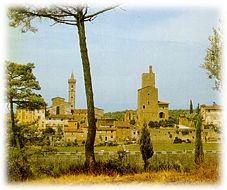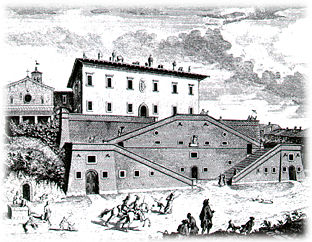The land of the Renaissance
Our itinerary in fact starts out from the Parish Church of SS. Ippolito e Cassiano, built in the 11th century along the ancient mediaeval route that linked up the Francigena road (now the provincial road connecting Ginestra with Montelupo). The church is a simple construction on a Latin cross design, with an asymmetric facade and a beautiful bell tower. The approach to Montelupo is extremely suggestive from this road: after crossing the ancient bridge over the Pesa, we soon come to the centre of the town, which contains a great many unique artistic treasures. We must now leave Corso Garibaldi, the main road, and turn left into Via Baccio Sinibaldi (architect and sculptor, better known as Baccio da Montelupo), to get to the Parish Church of San Giovanni Evangelista (with a Madonna enthroned attributed to Botticelli and his school in the interior). This is followed by the Palazzo Pretorio, decorated with the glazed shields of the podestas and now the home of the fascinating Archeological and Ceramics Museum, opened in 1983. We must now climb up the hill from the Museum to reach the ruins of the Castle, which contains the Parish Church of San Lorenzo, enlarged during the Renaissance.

Vinci, panoramic view with the Castle of the Conti GuidiWe advise you to take a stroll through the town of Montelupo before leaving, in order to explore the many shops selling artistic ceramics. Instead of taking the state road for Empoli, we must make a slight detour to visit the Oratory dell'Erta, and then head for the 16th century Medici Villa of Ambrogiana, perhaps built on a design by Bernardo Buontalenti and now the headquarters of the O.P.G. Leaving the villa behind us, we next head for Fibbiana, where we can find the massive Villa Mannelli, and then Pontorme, a suburb of Empoli and the birthplace of the painter Jacopo Carrucci, known as Pontormo (1494-1556), who carried out the painting of St. John the Evangelist and the Archangel Michael in the Church of San Michele when he was still only a young man.
It is almost obligatory to start any visit to Empoli, the home of glass, with Piazza Farinata degli Uberti. It is lined with many splendid buildings like, for example, the Collegiate of Sant'Andrea, rebuilt in around 1093, Palazzo Pretorio and Palazzo Ghibellino, where, in the famous "parliament" of 1260, Farinata degli Uberti saved Florence from destruction. Empoli not only possesses the important Museum of the Collegiate of Sant'Andrea (works by Lorenzo Monaco, Filippo Lippi, Antonio Rossellino...), it also boasts three other wonderful masterpieces of art: the Church of Santo Stefano degli Agostiniani (1367, with frescoes by Masolino); the Church of the Madonna del Pozzo and the Church of Santa Maria a Ripa (panel by Jacopo Chimenti known as Empoli, 1597).
Cerreto Guidi, Villa Isabella in an 18th century printCrossing the Arno, we continue our itinerary by heading for Vinci (which hosts the "Land of the Renaissance" Tourist Office), dominated by the old castle of the Guidi family, now the seat of the Leonardo Museum. The Leonardo Library next door contains the complete series of reproductions of all Leonardo's manuscripts and drawings. From here we advise you to take the "nature route", which consists in a delightful tour through the countryside along the ancient way that takes us from the Museum square to the village of Anchiano and the house where Leonardo was born: here we can find a reproduction of the fascinating "map of the Arno Valley" drawn by the Master. Our tour comes to an end at Cerreto Guidi, which lies between Padule di Fuceccio and Montalbano. The town takes its name from from the Counts Guidi, who dominated the castle from the 11th century onwards, and from the thick forests of Turkey oaks, that abound in game. Several ancient settlements of hunters from the Bronze Age (15 century B.C.) have been found here (in the village of Stabbia). With the departure of the Counts Guidi, in the second half of the 13th century, Cerreto became one of the many country districts under the rule of Florence and, in later years, was to be very popular with the Medici family, who built one of their country villas here. Designed in 1565 by Buontalenti for Cosimo I on a very similar design to Fort Belvedere, the villa is unfortunately famous for having been, in 1576, the scene of the assassination of Isabella de' Medici, who was strangled, out of jealousy, by her husband Paolo Giordano Orsini.
<- PAGE 1

©MEGA Via Lombroso 6/5 a
50134 Firenze
fax +39 055 412931
Email mega@mega.it
